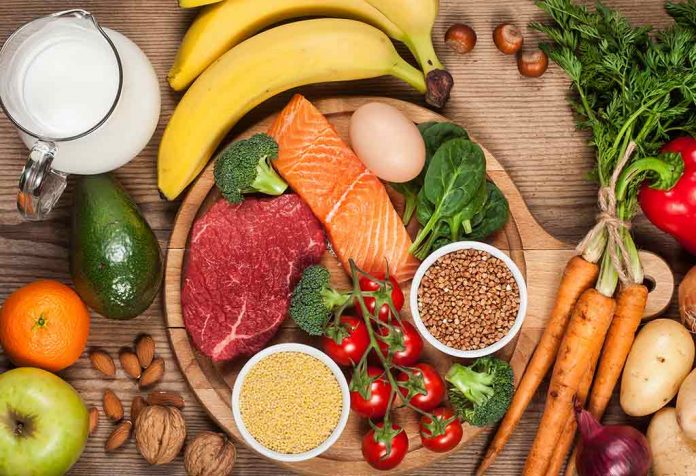What is it?
Calories|Importance|What to eat|Putting it together|Bottom line
Generally, a healthy diet consists of many fresh fruits and vegetables and limits processed foods. But ask your doctor or a dietitian for advice on making more specific dietary changes to improve your health.
What is a balanced diet?
A balanced diet gives your body the nutrients it needs to function correctly. To get the nutrition you need, most of your daily calories should come from:
fresh fruits|fresh vegetables|whole grains|legumes|nuts|
lean proteins
The Dietary Guidelines for explain how much of each nutrient you should consume daily.
About calories
The number of calories in a food refers to the amount of energy stored in that food. Your body uses calories from food for walking, thinking, breathing, and other important functions.
The average person needs about 2,000 calories every day to maintain their weight, but the amount will depend on their age, sex, and physical activity level.
Males tend to need more calories than females, and people who exercise need more calories than people who don’t.
Current guidelinesTrusted Source list the following calorie intakes for males and females of different ages:
The source of your daily calories are also important. Foods that provide mainly calories and very little nutrition are known as “empty calories.”
Examples of foods that provide empty calories include:
cakes, cookies, and donuts
processed meats
energy drinks and sodas
fruit drinks with added sugar
ice cream
chips and fries
pizza
sodas
However, it’s not only the type of food but the ingredients that make it nutritious.
A homemade pizza with a wholemeal base and plenty of fresh veggies on top may be a healthy choice. In contrast, premade pizzas and other highly processed foods often contain empty calories.
To maintain good health, limit your consumption of empty calories and instead try to get your calories from foods that are rich in other nutrients.
Get some tips for curbing cravings of less nutritious foods.
Why a balanced diet is important
A balanced diet supplies the nutrients your body needs to work effectively. Without balanced nutrition, your body is more prone to disease, infection, fatigue, and low performance.
Children who don’t get enough healthy foods may face growth and developmental problems, poor academic performance, and frequent infections.
They can also develop unhealthy eating habits that may persist into adulthood.
Without exercise, they’ll also have a higher risk of obesity and various diseases that make up metabolic syndrome, such as type 2 diabetes and high blood pressure.
According to the Center for Science in the Public Interest, 4 of the top 10 leading causes of death in the United States are directly linked to diet.
These are:
heart disease
cancer
stroke
type 2 diabetes
What to eat for a balanced diet
A healthy, balanced diet will usually include the following nutrients:
vitamins, minerals, and antioxidants
carbohydrates, including starches and fiber
protein
healthy fats
A balanced diet will include a variety of foods from the following groups:
fruits
vegetables
grains
dairy
protein foods
Examples of protein foods include meat, eggs, fish, beans, nuts, and legumes.
People who follow a vegan diet will focus entirely on plant-based foods. They won’t eat meat, fish, or dairy, but their diet will include other items that provide similar nutrients.
Tofu and beans, for example, are plant-based sources of protein. Some people are intolerant of dairy but can still build a balanced diet by choosing a variety of nutrient-rich replacements.
Foods to avoid
Foods to avoid or limit on a healthy diet include:
highly processed foods
refined grains
added sugar and salt
red and processed meat
alcohol
trans fats
What’s healthy for one person may not be suitable for another.
Whole wheat flour can be a healthy ingredient for many people but isn’t suitable for those with a gluten intolerance, for example.
Learn about 50 super healthy foods.
Fruits
Fruits are nutritious, they make a tasty snack or dessert, and they can satisfy a sweet tooth.
Local fruits that are in season are fresher and provide more nutrients than imported fruits.
Fruits are high in sugar, but this sugar is natural. Unlike candies and many sweet desserts, fruits also provide fiber and other nutrients. This means they’re less likely to cause a sugar spike and they’ll boost the body’s supply of essential vitamins, minerals, and antioxidants.
If you have diabetes, your doctor or dietitian can advise you on which fruits to choose, how much to eat, and when.
Vegetables
Vegetables are a key source of essential vitamins, minerals, and antioxidants. Eat a variety of vegetables with different colors for a full range of nutrients.
Dark, leafy greens are an excellent source of many nutrients. They include:
spinach
kale
green beans
broccoli
collard greens
Swiss chard
Local, seasonal vegetables are often reasonable in price and easy to prepare. Use them in the following ways:
as a side dish
roasted in a tray with a splash of olive oil
as the base in soups, stews, and pasta dishes
as a salad
in purées
in juices and smoothies
Grains
Refined white flour is featured in many breads and baked goods, but it has limited nutritional value. This is because much of the goodness is in the hull of the grain, or outer shell, which manufacturers remove during processing.
Whole grain products include the entire grain, including the hull. They provide additional vitamins, minerals, and fiber. Many people also find that whole grains add flavor and texture to a dish.
Try switching from white breads, pastas, and rice to whole grain options.
Proteins
Meats and beans are primary sources of protein, which is essential for wound healing and muscle maintenance and development, among other functions.
Animal protein
Healthy animal-based options include:
red meats, such as beef and mutton
poultry, such as chicken and turkey
fish, including salmon, sardines, and other oily fish
Processed meats and red meats may increase the risk of cancer and other diseases, according to some .
Some processed meats also contain a lot of added preservatives and salt. Fresh, unprocessed meat is the best option.
Plant-based protein
Nuts, beans, and soy products are good sources of protein, fiber, and other nutrients.
Examples include:
lentils
beans
peas
almonds
sunflower seeds
walnuts
Tofu, tempeh, and other soy-based products are excellent sources of protein and are healthy alternatives to meat.
Shop for tofu and tempeh.
Dairy
Dairy products provide essential nutrients, including:
protein
calcium
vitamin D
They also contain fat. If you’re seeking to limit your fat intake, reduced fat options might be best. Your doctor can help you decide.
For those following a vegan diet, many dairy-free milks and other dairy alternatives are now available, made from:
flax seed
almonds and cashews
soy
oats
coconut
These are often fortified with calcium and other nutrients, making them excellent alternatives to dairy from cows. Some have added sugar, so read the label carefully when choosing.
Shop for almond and soy milk.
Fats and oils
Fat is essential for energy and cell health, but too much fat can increase calories above what the body needs and may lead to weight gain.
In the past, guidelines have recommended avoiding saturated fats, due to concerns that they would raise cholesterol levels.
More recent suggests that partially replacing with unsaturated fats lowers cardiovascular disease risk and that some saturated fat should remain in the diet — about 10 percent or less of calories.
Trans fats, however, should still be avoided.
Recommendations on fats can sometimes be hard to follow, but one has proposed the following guideline:
Fats to love: vegetable oils and fish oils
Fats to limit: butter, cheese, and heavy cream
Fats to lose: trans fats, used in many processed and premade foods, such as donuts
Most experts consider olive oil to be a healthy fat, and especially extra virgin olive oil, which is the least processed type.
Deep fried foods are often high in calories but low in nutritional value, so you should eat them sparingly.
Shop for olive oil.
Putting it all together
A healthy diet will combine all the nutrients and foods groups mentioned above, but you need to balance them, too.
A handy way to remember how much of each food group to eat is the plate method. The USDA’s “ChooseMyPlate” initiative recommends:
filling half your plate with fruits and vegetables
filling just over one quarter with grains
filling just under one quarter with protein foods
adding dairy on the side (or a nondairy replacement)
But individual needs will vary, so the USDA also provides an interactive tool, “MyPlate Plan” where you can enter your own details to find out your personal needs.





























